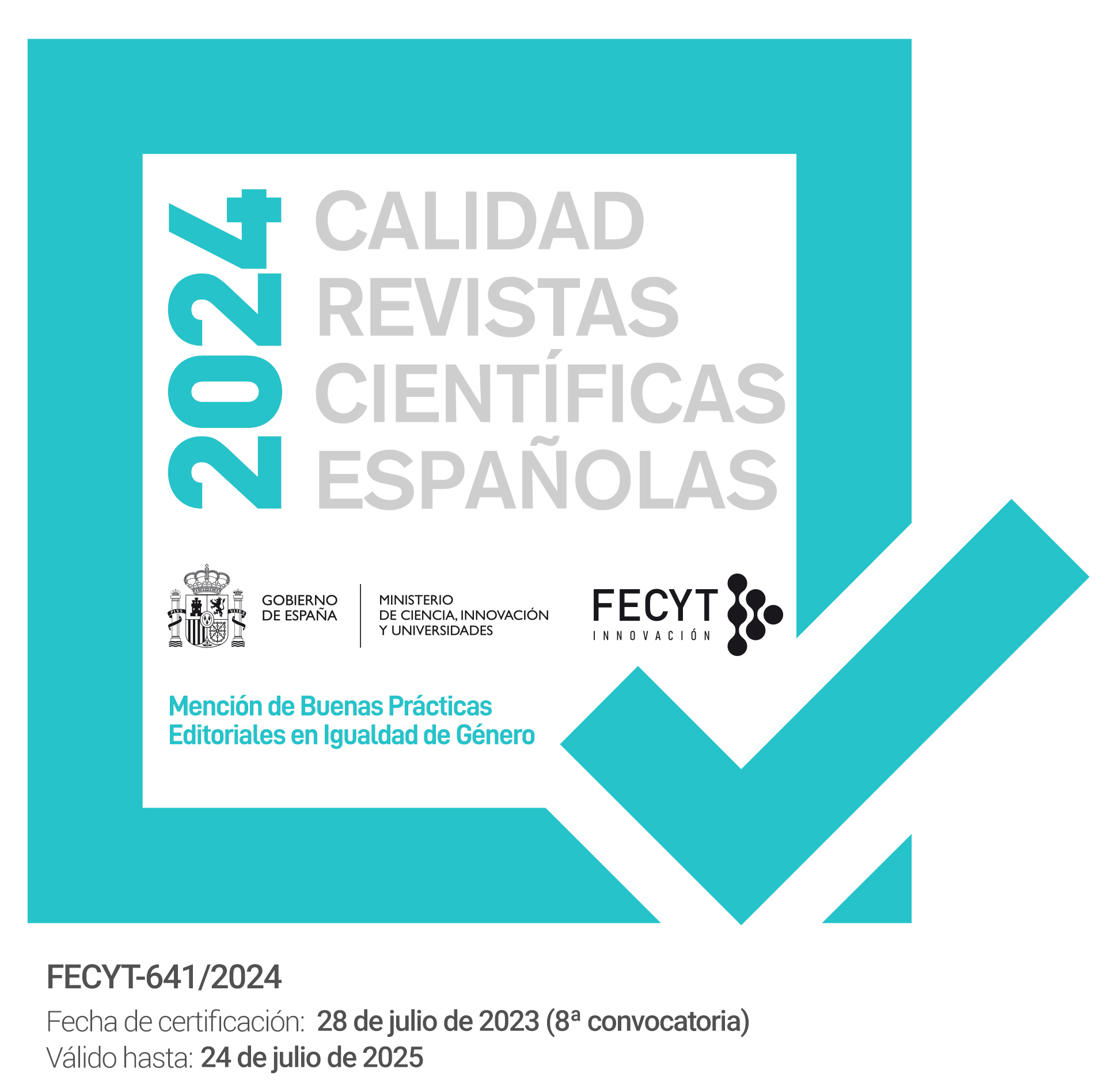Iconicity and diachrony: Ancient Greek /i-/stem
DOI:
https://doi.org/10.12795/PH.2023.v37.i01.04Keywords:
Iconicity, Diachrony, Morphosemantics, Child Language, Proper NameAbstract
The aim of this paper is to present an analysis of the Ancient Greek /i-/stem noun category from a semantic, diachronic and interlinguistic point of view, employing the main advances in categorization, phonetic iconicity, linguistic acquisition and proper name theory, focusing, unlike other precedent papers (Monzó 2016; 2017; 2019), on the role of phonetic iconicity of [i] in the historical development of the category. This approach shows, as a result, the semantic nature of Ancient Greek noun stems and suggests a close correlation between the palatal phoneme /i/ and the expression of affection in this language, which is understood as the iconic origin of the emergence of the /-i/ suffix, the main morphological feature of the category.
Downloads
References
Adrados, F. R., Bernabé, A. y Mendoza, J. (1996). Manual de Lingüística Indoeuropea (Vol. II). Ediciones Clásicas.
Aguirre, C., Albalá, M. J. y Marrero, V. (2004). “Mami, te quierito”. La adquisición del diminutivo en español. En M.A. Mayor, B. Zubiauz y E. Díez-Villoria (eds.), Estudios sobre la adquisición del lenguaje (pp. 120–144). Publicaciones de la Universidad de Salamanca.
Aikhenvald, A. Y. (2000). Classifiers. A Typology of Noun Categorization Devices. Oxford University Press.
Ballester, X. (1999). A propósito de lit. akis, ausis, nosis o sobre i predesinencial. Res Balticæ, (5), 81–90.
Ballester, X. (2003). A propósito de los adjetivos latinos en –ui–. Moenia, 9, 435–449.
Bodor, P., & Barcza, V. (2007). Acquisition of diminutives in Hungarian. In I. Savickienė y W. U. Dressler (Eds.), Acquisition of Diminutives. A cross-linguistic Perspective (pp. 231–262). John Benjamins Publishing. https://doi.org/10.1075/lald.43.10bod
Brugmann, K., & Delbrück, B. (1967). Grundriss der vergleichenden Grammatik der indogermanischen Sprachen. Karl J. Trübner.
Carnap, R. (1947). Meaning and Necessity. A Study in Semantics and Modal Logic. University of Chicago Press.
Chantraine, P. (1933). La formation des noms en grec ancien. Klincksieck.
Dressler, W. U., & Barbaresi, L. M. (1994). Morphopragmatics. Diminutives and Intensifiers in Italian, German and Other Languages. Mouton de Gruyter. https://doi.org/10.1515/9783110877052
Dressler, W.U., Lettner, L.E., & Korecky-Kröll, K. (2012). Acquisition of German diminutive formation and compounding in a comparative perspective: Evidence for typology and the role of frequency. In F.Kiefer, M. Ladány y P. Siptár (eds.) Current Issues in Morphologycal Theory: (Ir)regularity, analogy and frequency: Selected Papers from the 14th International Morphology Meeting. Budapest. 13-16 May 2010 (pp. 237-4). John Benjamins Publishing Company. https://doi.org./10.1075/cilt.322.11dre
Eichler, E., Hilti, G., Löffler, H., Steger, H., & Zgusta, L. (Eds.). (1995). Namenforschung. Ein internationals Handbuch zur Onomastik. 1. Teilband. Walter de Gruyter., https://doi.org/10.1515/9783110114263.1
Ferguson, Ch. A. (1964). Baby Talk in Six Languages. American Anthropologist, (66), 103–114. https://doi.org/10.1525/aa.1964.66.suppl_3.02a00060
Giannakis, G. K. (Ed.). (2014). Encyclopedia of Ancient Greek Language and Linguistics (Vols. 1–3). Brill.
Grinevald, C. (2004). Classifiers. Morphologie, 17(2), 1016-31. https://doi.org/10.1515/9783110172782.2.13.1016
Heine, B., & Kuteva, T. (2002). World Lexicon of Grammaticalization. Cambridge University Press., https://doi.org/10.1017/CBO9780511613463
Holton, D., & Manolessou, I. (2010). Medieval and Early Modern Greek. In E. J. Bakker (Ed.), A Companion to the Ancient Greek Language (pp. 539–563). Wiley-Blackwell., https://doi.org/10.1002/9781444317398.ch36
Hora, A., Ben-Zvi, G., Levie, R., & Ravid, D. (2007). Acquiring diminutive structures and meanings in Hebrew. In I. Savickienė y W. U. Dressler (Eds.), Acquisition of Diminutives. A cross-linguistic Perspective (pp. 295–317). John Benjamins Publishing., https://doi.org/10.1075/lald.43.13hor
Jakobson, R., & Waugh, L. R. (1980). La charpente phonique du langage. Les Éditions de Minuit.
Jespersen, O. (1960). Symbolic value of the vowel I. In O. Jespersen (Ed.), Selected writings of Otto Jespersen (pp. 557-579). George Allen y Unwin Ltd.
Jurafsky, D. (1996). Universal Tendencies in the Semantics of the Diminutive. Language, 72(3), 533–578. https://doi.org/10.2307/416278
Kripke, S. A. (1972). Naming and Necessity. Harvard University Press., https://doi.org/10.1007/978-94-010-2557-7_9
Lakoff, G. (1987). Women, Fire and Dangerous Things. What Categories Reveal about the Mind. University of Chicago Press., https://doi.org/10.7208/chicago/9780226471013.001.0001
Luraghi, S. (2011). The origin of the Proto-Indo-European gender system: Typological considerations. Folia Linguistica, 45(2), 435–464. https://doi.org/10.1515/flin.2011.016
Marrero, V., Aguirre, C., & Albalá, M. J. (2007). The acquisition of diminutives in Spanish. A useful device. In I. Savickienė y W. U. Dressler (Eds.), Acquisition of Diminutives. A cross-linguistic Perspective (pp. 155–181). John Benjamins Publishing., https://doi.org/10.1075/lald.43.07mar
Mattiello, E. (2013). Extra-grammatical Morphology in English. Abbreviations, Blends, Reduplicatives, and Related Phenomena. De Gruyter Mouton., https://doi.org/10.1515/9783110295399
Monzó, C. (2016). El tema en -ι en griego antiguo. Liburna, (9), 89–115.
Monzó, C. (2017). Hipocorístico en /-i/: Iconismo fonético de la afectividad. RSEL, 47(2), 7–28.
Monzó, C. (2019). Los hipocorísticos griegos en –ις: Contribución a la interpretación semántica del tema en –ι. CFC [g], (29), 11–32. https://doi.org/10.5209/CFCG.63582
Moreno Cabrera, J. C. (1997). Introducción a la Lingüística. Enfoque Tipológico y Universalista. Síntesis.
Moreno Cabrera, J. C. (2017). Claves históricas de la lingüística actual. Síntesis.
Moreno Cabrera, J. C. (2018). Origen y evolución de la gramática. Síntesis.
Ohala, J. J. (1997). Sound symbolism. In Proceedings of the 4th Seoul International Conference on Linguistics [SICOL] 11-15 Aug. 1997 (pp. 98-103). Linguistic Society of Korea.
Protassova, E., & Voeikova, M. (2007). Diminutives in Russian at the early stages of acquisition. In I. Savickienė y W. U. Dressler (Eds.), Acquisition of Diminutives. A cross-linguistic Perspective (pp. 43–72). John Benjamins Publishing., https://doi.org/10.1075/lald.43.03pro
Savickienė, I. (2007). Form and meaning of diminutives in Lithuanian child language. In I. Savickienė y W. U. Dressler (Eds.), Acquisition of Diminutives. A cross-linguistic Perspective (pp. 13–41). John Benjamins Publishing., https://doi.org/10.1075/lald.43.02sav
Savickienė, I., & Dressler, W. U. (Eds.). (2007). Acquisition of Diminutives. A cross-linguistic Perspective. John Benjamins Publishing., https://doi.org/10.1075/lald.43
Schieffelin, B. B., & Ochs, E. (1996). The microgenesis of competence: Methodology in language socialization. In I.D. Slobin, J. Gerhardt, A. Kyratzis y J. Guo (Eds.), Social interaction, social context and language: Essays in honor of Susan Ervin-Tripp (pp. 251–264). Lawrence Erlbaum Associates.
Schwyzer, E. (1939). Griechische Grammatik. Allgemeiner Teil. Lautlehre, Worbildung. Flexion. I. Band. C.H. Beck’sche Verlagsbuchhandlung.
Simone, R. (Ed.). (1994). Iconicity in Language. John Benjamins Publishing Company.
Ultan, R. (1978). Size-Sound Symbolism. In J. H. Greenberg (Ed.), Universals of Human Language (Vol. 2: 526–568). Stanford University Press.
Vendryes, J. (1904). Traité d’accentuation grecque. Klincksieck.
Fuentes documentales
DGE = Rodríguez Adrados, F. y Rodríguez Somolinos, J. (Dirs.) (1980-). Diccionario Griego-Español. CSIC (7 vols.). http://dge.cchs.csic.es/xdge/
LGPN = Parker, R. (Dir.) (1987-2018). Lexicon of Greek Personal Names. Oxford University Press (8 vols.). http://www.lgpn.ox.ac.uk/
LSJ = Liddell, H.G., Scott, R. y Jones, H.S. (1996). A Greek–English Lexicon. Oxford University Press. http://stephanus.tlg.uci.edu/lsj/
TLG = Pantelia, M.C. (Dir.) (1972-). Thesaurus Linguae Graecae. Digital Library. University of California, Irvine. http://www.tlg.uci.edu
Published
How to Cite
Issue
Section
License
Copyright (c) 2023 Carlos Monzó Gallo

This work is licensed under a Creative Commons Attribution-NoDerivatives 4.0 International License.
The printed and electronic editions of this Journal are edited by the University of Seville Editorial, and the source must be cited in any partial or total reproduction.
Unless otherwise indicated, all the contents of the electronic edition are distributed under a license of use and distribution “Attribution-NonCommercial-NoDerivatives 4.0 International” . You can view the informative version and the legal text of the license here. This fact must be expressly stated in this way when necessary.
Authors who publish in this journal accept the following conditions:
- The author/s retain copyright and grant the journal the first publication right, and accept it to be distributed with the Creative Commons By NC ND 4.0 licence, which allows third parties to use what is published whenever they mention the authorship of the work and the first publication in this journal and whenever they do not make commercial use and reuse it in the same way.
- Authors can make other independent and additional contractual agreements for the non-exclusive distribution of the article published in this journal (e.g., include it in an institutional repository or publish it in a book) provided they clearly indicate that the work was published for the first time in this journal.
Authors are allowed and recommended, once the article has been published in the journal Philologia Hispalensis (online version), to download the corresponding PDF and disseminate it online (ResearchGate, Academia.edu, etc.) as it may lead to productive scientific exchanges and to a greater and faster dissemination of published work (see The Effect of Open Access).
Accepted 2022-11-16
Published 2023-07-28
- Abstract 149
- HTML (Español (España)) 29
- PDF (Español (España)) 153
- XML (Español (España)) 18







